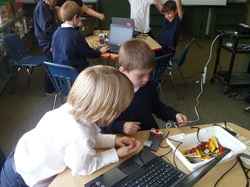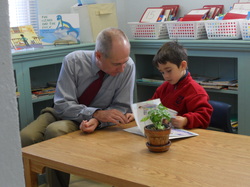
One experience during this time still stands out for me. I was in a classroom in a university laboratory school in Hiroshima. At the front of the class was a senior mathematics teacher – back to the room – scribbling formulas on the whiteboard and muttering fairly incomprehensively about what he was doing. At the back of the class were ten student teachers furiously copying down everything that he wrote so that they could someday use it in their own classrooms. In between were forty Grade 12 students who were paying no attention whatsoever. There were lots of conversations going on, some outstandingly artistic doodles being created, and a number of people catching up on an obvious lack of sleep – but no-one was actually learning mathematics. In my post-class focus groups, I discovered two things. To begin with, the teacher felt that it was his responsibility to teach, but not to ensure that anyone actually learned. Secondly, the students felt that it was their responsibility to learn, but that the venue for that was not school, it was at home or at an after school cram session where they would spend hours self-teaching and practicing problems. It was this disconnect that the government was trying to address. The challenge was, that the issue was more cultural than pedagogical.
You know what Neil Postman would say, “I taught it, it’s just that they didn’t learn it” is akin to hearing a car salesperson say “I sold it, it’s just that they didn’t buy it”. We know that effective teaching and learning is an interactive process, and that to be meaningful, both partners have to actively engage in it. The transmission culture that brought us radio and television is rapidly being supplanted by the interactive culture that uses Google and Wikipedia and invites the user to engage and generate knowledge, not just receive and record it.
At Kenneth Gordon, like most schools, we sometimes fall into the trap of assigning what we feel should be a simple task and finding that a student has become paralyzed and unable to proceed. Even with the luxury of small class groupings and daily individual instruction, we are constantly presented with a variety of learning puzzles. Why did this student balk at this task when the nine who came before breezed through it? What necessary steps did I leave out, that account for my inability to engage this particular learner in a fashion that would enable her or him to feel confident in their ability to take this on?
This is a pivotal moment in the teaching/learning process. We can just shrug and pat ourselves on the back for a 90% success rate or, we can double down and become learning detectives, committed to finding the piece of the puzzle that eludes us. The response to this challenge is a window into the culture of a school.
All students have a unique approach to learning. Most fall within a broad range that is typically addressed in school, but many are outliers. They have great, untapped potential that needs to be coaxed to the surface, nurtured and reinforced. It is hard work, for both educator and learner, but the possibilities are endless. Part of our challenge is to make students understand this correlation between work and performance, between perseverance and progress.
In 2008, author Malcolm Gladwell, in his book The Outliers, looked at predictors for success in international, standardized mathematics examinations. It was his rather astounding discovery, that there was a direct correlation between how students filled out their demographic information with how they performed on the test. Those students who were disciplined enough to complete the two pages of identifying data (birth date, gender, level of education, etc.) did significantly better on the exam than those students who rushed through the “boring” demographics and jumped feet first into the problems. Gladwell concluded that the issue in math performance in this instance was not pedagogy or even natural ability but, rather self-discipline and, ultimately, culture.
Helping students take a systematic approach to learning pays off. It means focusing less on content and more on attitude. It challenges us to ask: How can we create a culture of success? How can we help students to see that hard work and application is not boring but actually interesting and rewarding? How can we make our students understand that, just as they know that they have to spend hours practicing skating or soccer or dance or the saxophone in order to be proficient, the same is true in reading, or mathematics? I said earlier that teaching and learning is a partnership. But it is not just between school and student. It is a three- way commitment, with parents playing a crucial role, to build a culture of learning that becomes a norm for all of our children.






 RSS Feed
RSS Feed
